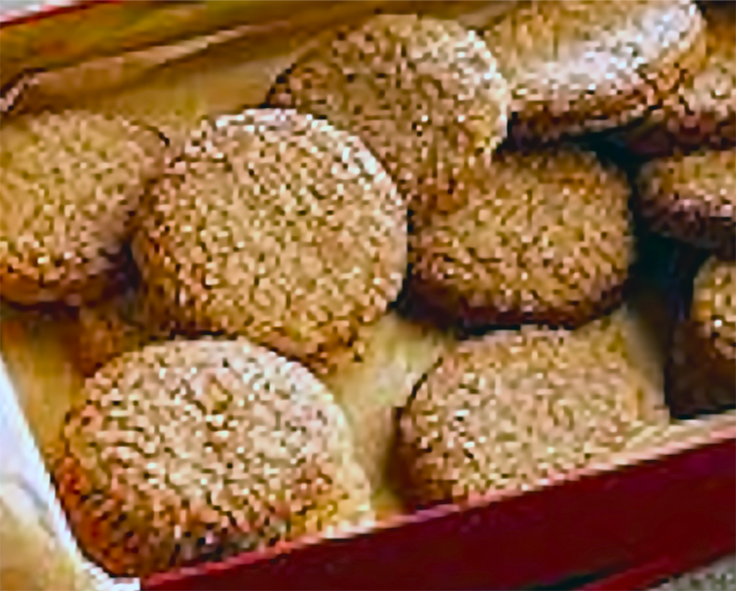
 Click on the image, above to submit to Pinterest.
Click on the image, above to submit to Pinterest.
Bisgedi Ceirch a Sbelt (Oat and Spelt Biscuits)
Bisgedi Ceirch a Sbelt (Oat and Spelt Biscuits) is a modern Cymric (Welsh) recipe for a classic biscuit made from a blend of oats and spelt that are intended for serving with cheese. The full recipe is presented here and I hope you enjoy this classic Welsh version of: Oat and Spelt Biscuits (Bisgedi Ceirch a Sbelt).
prep time
15 minutes
cook time
15 minutes
Total Time:
30 minutes
Makes:
15
Rating: 
Tags : Vegetarian RecipesMilk RecipesBritish RecipesCymric/Welsh Recipes
Original Recipe
Dyma bortread cyfoes o fara ceirch Cymreig traddodiadol sy'n gwneud y bisgedi'n fwy sawrus gyda ychwanegiad of flawd sbelt. Sbelt,
Triticum spelta (fel arall
Triticum aestivum subsp.
spelta) yw rhywogaeth o wenith (a elwir hefyd yn wenith dincel neu wenith noeth) sy'n cael ei werthfawrogi fel bwyd iach oherwydd ei gynnwys protein uchel a'i flas cneuog. Mae sbelt yn goddef priddoedd tir clai trwm yn dda ac mae wedi cael ei dyfu yng Nghymru ers canol yr Oes Haearn hyd at yr Oesoedd Canol lle’i ddisodlwyd gan rawn bara gwenith cyfoes, a haidd. Mae'n debyg mai ei enw Cymraeg gwreiddiol oedd un o'r gwenithiau coch a gyfeirir atunt mewn llawysgrifau'r Oesoedd Canol; er nad yw'r union enw yn hysbys. Yng Ngymraeg cyfoes gelwir y grawn yn ‘sbelt’. Mae'r fisged hyn wedi'i dylunio i fod yn sawrus ac yn addas o gael eu gweini gyda chaws.
Cynhwysion:
110g o flawd ceirch canolig
110g o flawd sbelt gwenith cyflawn
25g–50g o siwgr mân
¼ llwy de o halen môr
½ llwy de wastad o soda pobi
85g o fenyn
1 ŵy mawr, wedi’i guro
Dull:
Cymysgwch y blawd ceirch, y blawd, y siwgr, yr halen a’r soda pobi ynghyd.
Rwbiwch y menyn i mewn gyda blaen eich bysedd cyn ychwanegu’r ŵy a chymysgu’r cyfan yn dda.
Rhowch y toes ar arwyneb gweithio cyn taenu haen denau o flawd ceirch arno. Rowliwch y toes fel ei fod tua 1cm o drwch, a’i dorri’n gylchoedd 7cm.
Gosodwch y bisgedi ar dun pobi wedi’i iro a’u rhoi mewn popty wedi ei gyn-gynhesu i 190°C (170°C ffan/375°F/Nwy 5). Pobwch am 10–15 munud tan y byddan nhw wedi eu coginio ac yn euraidd.
English Translation
Here is a modern rendition of traditional Welsh oatcakes that makes the biscuits more savoury with the addition of spelt flour. Spelt,
Triticum spelta (alternatively Triticum aestivum subsp. spelta) is a species of wheat (also known as dinkel wheat or hulled wheat) that is valued as a health food for its high protein content and nutty taste. Spelt tolerates heavy clay soils well and has been cultivated in Wales since the middle Iron Age until the central Middle Ages where its cultivation was displaced by bread wheat and barley. It is likely that its original Welsh name was one of the red wheats referred to in Middle Age manuscripts, though the precise epithet remains unknown. In Modern Welsh the grain is known as sbelt. This biscuit is designed to be savoury and is best served with cheese.
Ingredients:
120g (1 cup) plain flour
2 eggs
2 tbsp melted butter
Pinch of salt
425ml (1 ¾ cups) milk or buttermilk
Currants
8 pieces of butter (for frying)
To serve:
runny honey
2 lemons, quartered
Method:
In a large bowl, whisk together the flour, eggs, butter (or oil) and salt, then slowly add the milk. Keep whisking until you attain a pouring consistency (like single cream); you may not need all the milk. Set the bowl aside for at least 20 minutes to cook.
Stir the batter to lift the flour then place a small, flat frying pan and place over medium-high heat. When it’s too hot to hold your hand close to add a pat of butter and when melted pour about 75ml (5 tbsp/¼ cup) of the batter onto the pan.
Immediately tilt and swirl the pan so the batter spreads evenly across the surface. Take a generous three finger pinch of currants and scatter on top of the batter.
When you see the edges start to curl up, gently lift and flip with a spatula. Cook for a further 2 minutes on the other side, just long enough to brown, and remove to a warm plate. Re-grease the pan, if needed, and repeat until all of your batter is gone. (Note that the first pancake almost always fails; usually as the pan is not hot enough; don’t worry, the next one will be fine.
Turn the pancake ‘ugly’ side up. (The side with the spots as opposed to the gentle marbling and where the currants poke out.) I usually sit on a plate in a low oven whilst the remaining pancakes cook.
To serve, bring the warm pancakes to the table and let everyone (carefully) fetch a pancake from the stack. Drizzle over a little honey, add a generous squeeze of lemon juice, roll and enjoy.

 Click on the image, above to submit to Pinterest.
Click on the image, above to submit to Pinterest.
